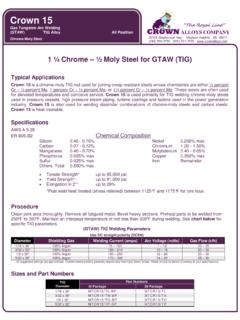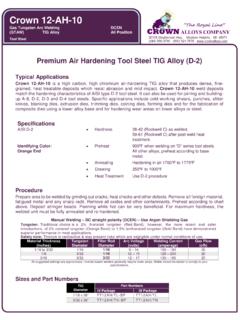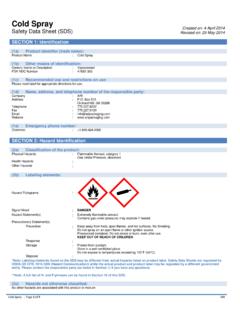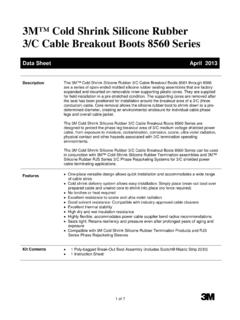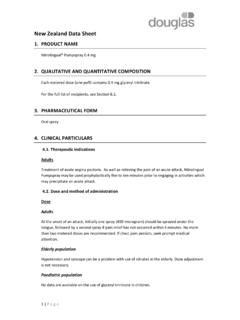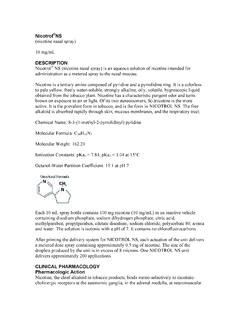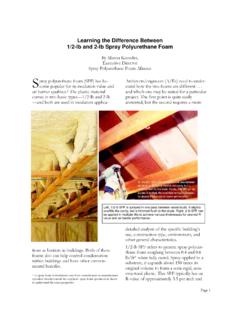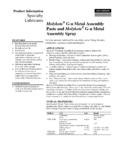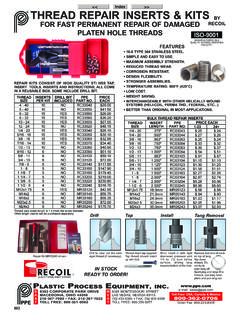Transcription of MATERIAL SAFETY DATA SHEET - Welcome to …
1 MSDS dy PAGE 1 of 4 CROWN-GALV SPRAY CROWN ALLOYS COMPANY MATERIAL SAFETY data SHEET Section 1 - COMPANY AND MATERIAL IDENTIFICATION PRODUCT TYPE: cold -galvanizing zinc primer in aerosol containers.
2 TRADE NAME: CROWN-GALV (aerosol) SPECIFICATION: N/A CLASSIFICATION: N/A VENDOR: Crown Alloys Company ADDRESS: 30105 Stephenson Hwy. Madison Heights, MI. 48071 TELEPHONE: (248) 588-3790 Emergency 24 hour telephone # CHEMTEL (800) 255-3924 WEBSITE: DATE: November 29, 2010 Section 2 - HAZARDOUS INGREDIENTS IMPORTANT! This section covers the MATERIAL from which these products are manufactured. The fumes and gases produced when welding with normal use of these products are covered in Section 5 & 6. Ingredient CAS No. OSHA TWA PEL (ACGIH TWA)1 TLV Carcinogen Ref. Source* Dichloromethane 75-09-2 25 ppm 5 ppm IARC and NTP Propane 74-98-6 1000 ppm 1000 ppm d Xylol 1330-20-7 100 ppm 100 ppm d Zinc Dust and Resin Binder 7440-66-6 200 ppm 200 ppm d VOC: Single values shown are maximum.
3 NIOSH classifies welding fumes as carcinogens. 1 The ACGIH has an established exposure limit for Welding Fumes, Not Otherwise Classified. That Threshhold Limit Value is 5 mg/m3. *Chemical Listed as Carcinogen or Potential Carcinogen. [a] NTP [b] IARC Monograph [c] OSHA [d] Not Listed [e] Animal data Only HMIS RATING (Hazardous Materials Information System) Health (blue) - 2 Flammability (red) - 2 Reactivity (yellow) - 0 Protective Equipment - B (See Section 7) Health Hazard: 0 (minimal acute or chronic exposure hazard); 1 (slight acute or chronic exposure hazard); 2 (moderate acute or significant chronic exposure hazard); 3 (severe acute exposure hazard; one time overexposure can result in permanent injury and may be fatal); 4 (extreme acute exposure hazard; onetime overexposure can be fatal).
4 Flammability Hazard: 0 (minimal hazard); 1 (materials that require substantial pre-heating before burning); 2 (combustible liquid or solids; liquids with a flash point of 38-93oC [100-200oF]); 3 (Class IB and IC flammable liquids with flash points below 38oC [100oF]); 4 (Class IA flammable liquids with flash points below 23oC [73oF] and boiling points below 38oC [100oF]. Reactivity Hazard: 0 (normally stable); 1 ( MATERIAL that can become unstable at elevated temperatures or which can react slightly with water); 2 (materials that are unstable but do not detonate or which can react violently with water); 3 (materials that can detonate when initiated or which can react explosively with water); 4 (materials that can detonate at normal temperatures or pressures). Caution: HMIS ratings are based on a 0-4 rating scale, with 0 representing minimal hazards or risks, and 4 representing significant hazards or risks.)
5 Although HMIS ratings are not required on MSDS's under 29 CFR , the preparer may choose to provide them. HMIS ratings are to be used only in conjunction with a fully implemented HMIS program by workers who have received appropriate HMIS training. HMIS is a registered trade and service mark of the NPCA. NFPA RATING HEALTH REACTIVITY FLAMMABILITY SPECIAL MSDS dy PAGE 2 of 4 CROWN-GALV SPRAY
6 CROWN ALLOYS COMPANY Section 3 - PHYSICAL and CHEMICAL CHARACTERISTICS APPEARANCE AND COLOR: Silver zinc coating; chlorinated solvent odor. SPECIFIC GRAVITY @ 20OC (water = 1): EVAPORATION RATE (Butyl Acetate = 1): >1 SOLUBILITY IN WATER: Insoluble BOILING POINT @ 760 mm Hg: N/A VAPOR DENSITY (AIR = 1): N/E WATER REACTIVE: No VAPOR PRESSURE: (PSIG @ 70OF (Aerosols): Max. 60 Section 4 - FIRE and EXPLOSION HAZARD data NATIONAL FIRE PROTECTION ASSOCIATION: Health Hazard: 0 ( MATERIAL that on exposure under fire conditions would offer no hazard beyond that of ordinary combustible materials); 1 (materials that on exposure under fire conditions could cause irritation or minor residual injury); 2 (materials that on intense or continued exposure under fire conditions could cause temporary incapacitation or possible residual injury); 3 (materials that can on short exposure cause serious temporary or residual injury); 4 (materials that under very short exposure causes death or major residual injury).)
7 Flammability Hazard: Refer to definitions for "HMIS RATING (Hazardous Materials Information System)" Reactivity Hazard: Refer to definitions for "HMIS RATING (Hazardous Materials Information System)" FLAMMABLE LIMITS (in air by volume, %): Lower (LEL): N/E Upper (UEL): N/E AUTO IGNITION TEMPERATURE: Unknown FLAMMABILITY as per USA FLAME PROJECTION TEST (aerosols): Flammable EXTINGUISHER MEDIA: Use media compatible with surrounding fire. Water, foam, dry chemical, carbon dioxide can be used. Brazing flame, welding arc and sparks can ignite combustibles and flammables. Refer to American National Standard SAFETY in Welding and Cutting and Safe Practices Code: SP, published by the American Welding Society for fire prevention during the use of welding, brazing and allied procedures. UNUSUAL FIRE AND EXPLOSION HAZARDS: At high temperatures above 120OF , overpressurization of containers can result.
8 Cans may burst. SPECIAL FIRE-FIGHTING PROCEDURES: Wear self-contained respiratory apparatus for protection. Storage containers exposed to fire and/or heat should be kept cool with water to prevent rupture. Section 5 - S TABILITY AND REACTIVITY data STABILITY: Stable HAZARDOUS POLYMERIZATION: Will not occur. CONDITIONS TO AVOID: Open flames, sparks and/or high temperatures, welding arcs. HAZARDOUS DECOMPOSITION PRODUCTS: HCl, CO, CO2, small amounts of phosgene and chlorine. MATERIALS WITH WHICH THIS PRODUCT IS INCOMPATIBLE: Alkalis, oxidizing materials, amines, potassium, magnesium, sodium and other active metals. Hazardous Decomposition Products Welding/brazing/soldering fumes and gases can not be classified simply. The composition and quantity of both are dependent upon the type of flux, the metal being soldered/brazed/welded and the rods used.
9 Other conditions which also influence the composition and quantity of the fumes and gases to which workers may be exposed include; Coatings on the metal being soldered/brazed/welded (such as paint, plating, or galvanizing), the number of welders, the volume of the work area, the quality and the amount of ventilation, the position of the welder's head with respect to the gas plume, the presence of contaminants in the atmosphere (such as chlorinated hydrocarbon vapors from cleaning and degreasing activities), the process and procedures, as well as the soldering/brazing/welding consumables. 2 0 2 0 MSDS dy PAGE 3 of 4 CROWN-GALV SPRAY CROWN ALLOYS COMPANY
10 Section 5 - STABILITY AND REACTIVITY data (continued) When this cold -galvanizing zinc primer is consumed, the fume and gas decomposition products generated are different in percent and form from the ingredients listed in Section 2. Decomposition products of normal operation include those originating from the volatilization, reaction, or oxidation of the materials shown in Section 2, plus those from the base metal, coatings, etc., as noted above. Gaseous reaction products may include carbon monoxide and carbon dioxide. Ozone and nitrogen oxides may be formed by the radiation from an arc, in addition to the shielding gases like argon and helium, whenever they are employed. One recommended way to determine the composition and quantity of fumes and gases to which workers are exposed is to take an air sample inside the welder's helmet if worn or in the worker's breathing zone.




